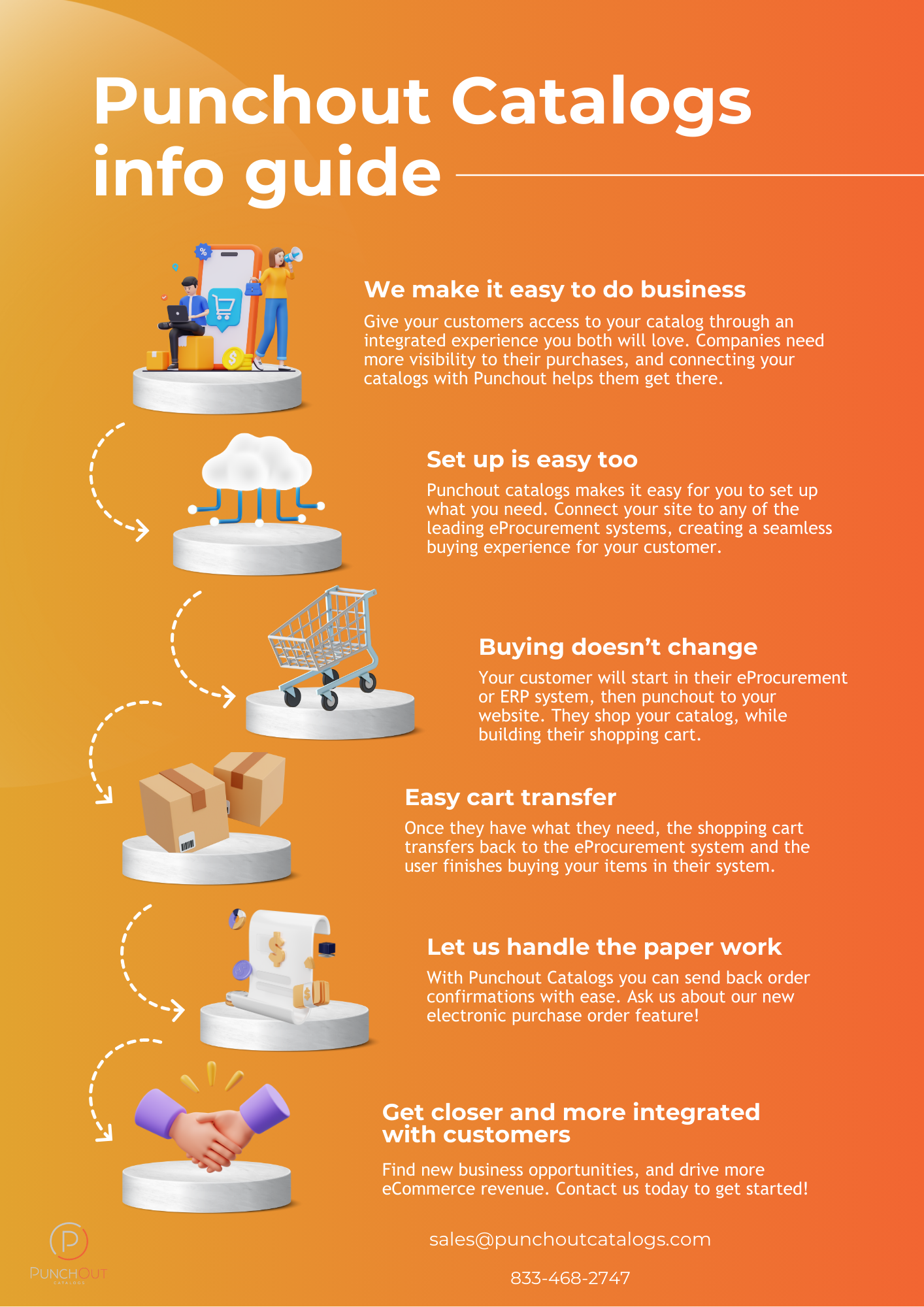and start selling to B2B Customers
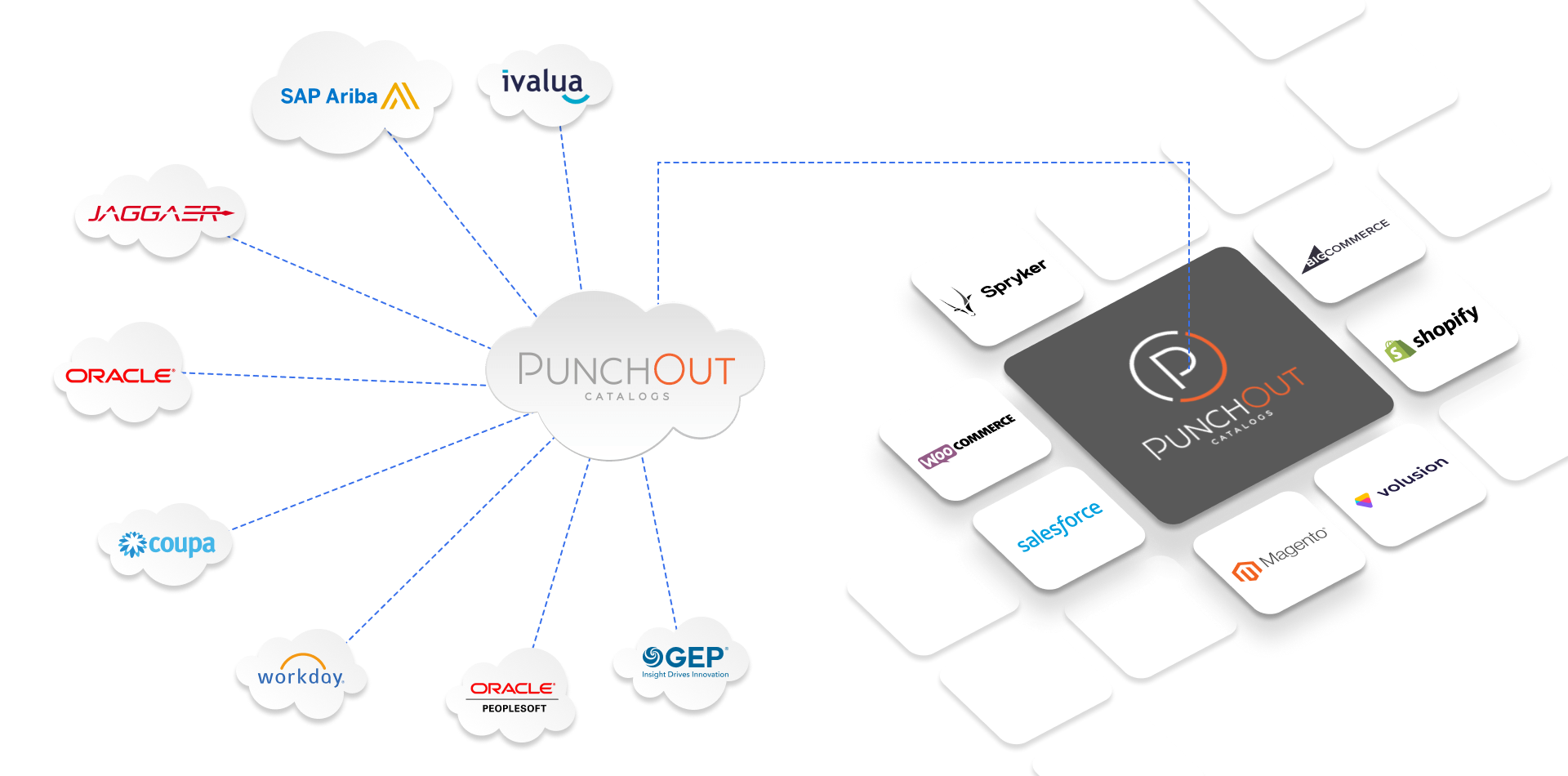




Learn more with our quick info guide
Get closer and more tightly integrated with your customers to boost your sales.
About us
Punchout Catalogs is a part of the BuyerQuest network
In 2009, Punchout Catalogs brought eProcurement to the B2B experience, helping countless suppliers connect to their buyers with a simple plug-in. Today Punchout Catalogs has evolved from custom solutions for eCommerce to selling numerous plug-ins through large platform marketplaces and app stores.We make it easy for your buyers to punchout to your store after they have selected their items for purchase. As a supplier, you can subscribe to as many or as few connections as you want, according to business needs, and on whatever platform you choose. Now a part of the BuyerQuest network, Punchout Catalogs remains passionate about serving suppliers by taking away the guesswork of punchout and taking care of the technical details so that all you have to do is focus on your product.
Punchout Catalogs offers pre-built integrations for Magento, Shopify, and BigCommerce options that can give any eCommerce site punchout capabilities.
PunchOut for Magento

Use our extension to convert your existing Magento site to a punchout capable B2B platform.
Connect with your customers for carts, purchase orders, shipment notices (ASN) and invoices using PunchOut Catalogs.
PunchOut for Shopify

Install our plugin to your Shopify store and start doing B2B business today.
After a quick setup, your customers can punchout to your store and create orders from their ERP or eProcurement platform.
PunchOut for BigCommerce

Add our plugin to your BigCommerce store and start doing B2B business today.
After a quick setup, your customers can punchout to your store and create orders from their ERP or eProcurement platform.
Feature updates & upgrades
Faster PO receipt directly from your buyers enabled on all plugins.
Pre-built connectivity with all major ERPs
and eProcurement Solutions

Connect with Coupa

Connect with SAP SRM and SAP Ariba

Connect with Jaggaer

Connect with PeopleSoft eProcurement

Connect with Oracle iProcurement

Connect with Ivalua

Connect with Workday

Connect with GEP
...and hundreds more
View All ⇒


VP of eCommerce

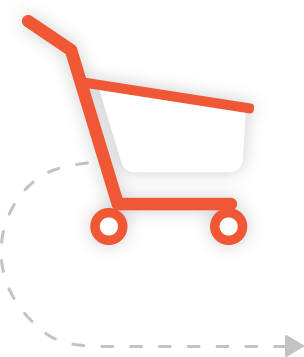
STEP ONE
Connect
The B2B shopping experience starts in your customer’s purchasing system. Users then initiate the punchout connection and data is transferred to your punchout enabled catalog.
This message is called a punchout setup request (PSR) and usually formatted in cXML or OCI formats.
Our plugins examine the incoming data and route the user to the correct catalog in your solution. This process can send users to co-branded catalogs that display customer specific pricing, product sub-sets and more.
STEP TWO
Shop
Upon connecting, users are logged into your eCommerce platform and can shop like any other user. Depending on the features of your eCommerce platform, you can show special prices or specific products to the user.
Customers find what they need and build a shopping cart in your platform. At check out, the user clicks a button to transfer the cart contents to their eProcurement or ERP platform.
At this point, our extension takes over and converts the shopping cart data into cXML or OCI formats that these platforms understand and maps the data according to the customer requirements. This process is called a shopping cart response.
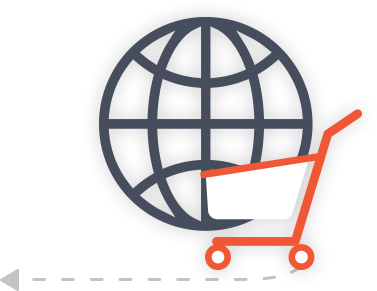
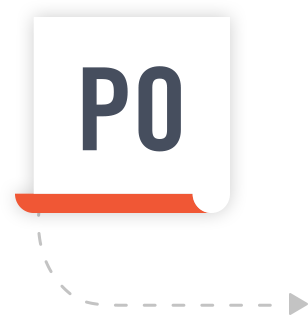
STEP THREE
Purchase Order
After the customer returns the items to their purchasing system, a number of steps happen outside of your view. This includes the application of budget, accounting information and approval of the purchase. All of this happens in the buyers system while you are waiting for the purchase order.
Once fully approved, the request (shopping cart) becomes a purchase order. Your buyer then sends the order to your system to begin the fulfillment process. With Punchout Catalogs, you have the ability to accept electronic purchase orders and automatically create corresponding orders in your system.
Punchout Catalogs offers multiple solutions to support this part of the process.
STEP FOUR
Shipment Notice
Like any consumer shopper, your buyers want to know when their items will arrive. In this step, you create a advanced shipment notice (ASN) in your eCommerce platform with tracking and shipment information.
The PunchOut catalogs extension then converts your shipment record into cXML format and sends the notice to your customer.
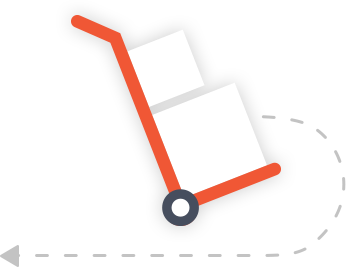

STEP FIVE
Invoice
If you want to get paid you have to submit an invoice. You can use our technology to generate an electronic invoice and speed the payment process and cut the paper processing time.
What is a punchout catalog?
In the punchout process the first step is to create a shopping cart in your punchout enabled catalog. The cart is then transferred to the external system to complete the punchout process. In our solution these are called transferred carts and the application keeps a grid showing the carts that have been transferred to external eProcurement and ERP systems.
After approval, the cart is converted to a purchase order and routed back to your system in the form of an order. It is important to keep in mind that a transferred cart is not yet an order and can be cancelled or modified before the purchase order is returned.
Are punchout connections based on standards?
What experience does PunchoutCatalogs have in this space?
After a decade of experience integrating other punchout solutions, PunchOut Catalogs offered their own platform in 2009. Since that time we have enabled thousands of suppliers to connect with their buyers in a true B2B environment.
Why are our customers asking for a Punchout Catalog?
In many cases having a punchout capable website can be required for suppliers to bid on opportunities.
How would my company benefit from having a Punchout enabled catalog?
Having punchout capabilities provides a large number of benefits for suppliers, most notably:
- Do business the way the largest companies in the world do business, i.e. via B2B eProcurement systems.
- Qualify for very large contracts with these large companies who require punchout capable suppliers.
- Provide a captive purchasing experience when they access your site.
- Upsell and/or crossell additional products and/or services.
- Gain valuable insights into what your customers are doing on your site, e.g. searching, browsing, and many other user behavior analytics.
The founders of PunchOut Catalogs were truly one of the early pioneers of punchout back in 1999.
After a decade of experience integrating other punchout solutions, PunchOut Catalogs offered their own platform in 2009. Since that time we have enabled thousands of suppliers to connect with their buyers in a true B2B environment.
You’ve been asked to provide a punchout catalog, What now?
You have two choices:
- DIY – Build a punchout capable system yourself or retrofit your existing ecommerce website to support the various punchout standards and idiosyncrasies.
- SaaS – Subscribe to a turn-key punchout capable solution that is guaranteed to exceed your customer’s technical requirements and likely even their expectations.
What’s different between hosted and PunchOut Catalog?
A hosted catalog is essentially a flat file (or multiple files) that contain information on your products or services. Your customer loads the file(s) into their internal eProcurement system.
A punchout catalog is an external website that your customer accesses from their eProcurement system.
What is a Level 2 PunchOut Catalog?
A Level 2 PunchOut catalog is essentially a combination of both a PunchOut website along with a catalog index file that lists all the items that can be found on your PunchOut website.
Providing this index file to your buyer allows them to search and find your products in their eProcurement system. Once clicked, the user then punches out directly to the product detail page on your PunchOut site.
What procurement systems can PunchOut Catalogs integrate with?
Can I auto-create users based on data provided in the punchout connection?
Yes, with our PunchOut Catalog solutions, the system can create users based on data contained in the punchout setup request.
What is the difference between cXML and OCI?
At a high level, cXML is a standard started by Ariba and adopted by most of the other eProcurement systems, except SAP.
OCI or “Open Catalog Interface” is similar in concept but a looser “standard” used almost solely by SAP.
What is custom mapping? Is that supported?
Yes, the platform provides the ability to map elements in your eCommerce platform to specific areas of the returned data. You can manage the mappings in the administrative interface and our team will help you with the initial mapping to meet your needs.
What experience does PunchoutCatalogs have in this space?
After a decade of experience integrating other punchout solutions, PunchOut Catalogs offered their own platform in 2009. Since that time we have enabled thousands of suppliers to connect with their buyers in a true B2B environment.
Talk to Sales
Connect with our team to discuss your project and get started with B2B integration.

